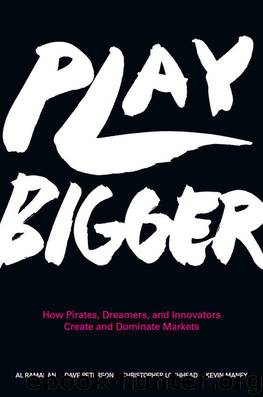Play Bigger: How Pirates, Dreamers, and Innovators Create and Dominate Markets by Al Ramadan & Dave Peterson & Christopher Lochhead & Kevin Maney

Author:Al Ramadan & Dave Peterson & Christopher Lochhead & Kevin Maney
Language: eng
Format: mobi
Publisher: HarperCollins
Published: 2016-06-13T14:00:00+00:00
A Few Things Most CEOs Never Think of Doing
We’re pretty sure that few people reading this have drawn up a blueprint for their category or a taxonomy that names everything for the category, or thought through the category’s use cases, or painted a picture of an ecosystem. We’ll tell you what that stuff is and why we believe you should do these things in the charge toward the lightning strike. We’re not saddling you with a meaningless pile of consultant-y make-work. This is the business equivalent of writing a script and laying out a storyboard for a movie instead of letting everybody improvise. The good news is that much of what you need is probably already floating around the company. Hopefully this work will capitalize on and amplify work that’s already been done but hasn’t been assembled in a cohesive manner.
We realize we’re going to hit you with a lot of to-dos in these next pages. We recommend you break at some point and open a bottle of something with alcohol in it.
Let’s say you’ve finished your POV and set a date for the lightning strike. As every department starts planning its drive to the strike, the leadership team should sit down and thoroughly imagine the category the company is trying to create. But just imagining the category is not enough. You need to make the implicit become explicit. We recommend creating four seminal documents: a category blueprint, product taxonomy, customer use cases, and category ecosystem. If you’re inside a well-funded start-up, the output of this work should look well honed and professional. But a two-person start-up in a backyard shed or an individual designing a career might do this on the back of a napkin. The most important part is that you think these things through and write them down.
Category blueprint: Category kings design the product, company, and category at the same time. The blueprint marks the start of designing the category. If you’re different and not just better . . . if you’re nonconsensus and hope to flip over to consensus . . . that means your category does not yet exist. You have to invent and design it. And then you have to put it on paper in a way that helps employees, customers, investors, analysts, and the media comprehend how the category should work and what role you’ll play in it. Many companies develop a product road map that details how a product will evolve and what its end state might look like. This does something similar, but for the whole category.
The blueprint is a design for how the product or service will work going forward. It should tell customers what they can expect the category king to deliver. A public company can’t publish a product road map because it is considered a forward-looking statement. But a category blueprint can and should be an external document. It is meant to show people what to expect over time from the category. It’s not a promise of what the company will deliver, but a vision of a category that the company wants to bring into existence.
Download
This site does not store any files on its server. We only index and link to content provided by other sites. Please contact the content providers to delete copyright contents if any and email us, we'll remove relevant links or contents immediately.
Bad Blood by John Carreyrou(6274)
Rich Dad Poor Dad by Robert T. Kiyosaki(6174)
Principles: Life and Work by Ray Dalio(5957)
Playing to Win_ How Strategy Really Works by A.G. Lafley & Roger L. Martin(5492)
Management Strategies for the Cloud Revolution: How Cloud Computing Is Transforming Business and Why You Can't Afford to Be Left Behind by Charles Babcock(4438)
The Confidence Code by Katty Kay(4035)
Thinking in Bets by Annie Duke(3995)
American Kingpin by Nick Bilton(3505)
Delivering Happiness by Tony Hsieh(3280)
Project Animal Farm: An Accidental Journey into the Secret World of Farming and the Truth About Our Food by Sonia Faruqi(3016)
The Power of Habit by Charles Duhigg(2964)
Brotopia by Emily Chang(2892)
Mastering Bitcoin: Programming the Open Blockchain by Andreas M. Antonopoulos(2890)
The Tyranny of Metrics by Jerry Z. Muller(2846)
I Live in the Future & Here's How It Works by Nick Bilton(2844)
The Marketing Plan Handbook: Develop Big-Picture Marketing Plans for Pennies on the Dollar by Robert W. Bly(2792)
The Content Trap by Bharat Anand(2778)
Building a StoryBrand by Donald Miller(2754)
Applied Empathy by Michael Ventura(2749)
